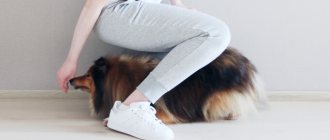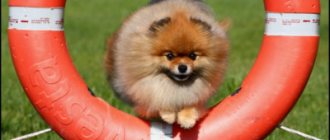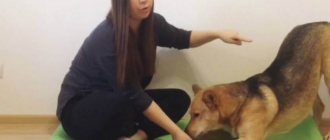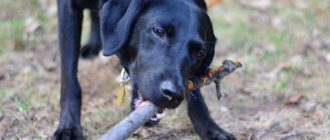Basic commands for dogs are extremely important. Your dog must be able to behave correctly. Since this greatly facilitates caring for the animal and communicating with it. Sometimes, the correct skills in mastering basic commands can save your beloved pet’s life. Here you can find out which commands are mandatory for your dog. How easy it is to teach her to do them.
Do you think that your dog behaves perfectly because it doesn’t bother people and hasn’t chewed or broken anything yet? This is a completely wrong approach to raising a pet. Training is necessary; it disciplines the animal. Helps the owner find a common language with his dog and give him the necessary behavior patterns in a given situation.
What dangers await a dog at home and on the street! Stop the animal in time, call it to you, prevent it from running away and getting lost... You never know what situations arise during a walk. This is a real opportunity to walk peacefully and enjoy the world around you. Because you will be confident in your dog - it will not do anything bad to other people. No one can hurt her. Just one word and the dog will obey you.
In addition, joint activities will bring great pleasure and will significantly strengthen the bond between the animal and the owner. Here are the 8 most important basic commands that you can use in your everyday life.
List of basic commands for each day:
- Sit
- Lie
- Stand
- It is forbidden
- Give
- Near
- To me
- Place
These commands are part of a general training course, which consists of teaching the dog various skills, including 11 basic commands. We won't touch on some of them in this article. For example, the command “Fas” or “Aport”. They are not as important in everyday life as those listed above.
Command "Sit"
This command is intended so that the dog can calm down, sit down, rest or wait for the owner. For example, if you are crossing the road together and stop in front of a pedestrian crossing. A dog can, even on a leash, run out onto the roadway. By giving her the “sit” command, you will be sure that the animal will not create an emergency situation, will not pester passers-by, etc.
This command is also perfect at home, when you need, for example, to put a collar or harness on your dog. You can use this command when you give your pet food. Then the dog will not jump on the owner, rush to the bowl or snatch food from his hands.
How to teach the Sit command:
You need to teach your dog the “sit” command in a calm environment, so that nothing distracts its attention. The animal must feel comfortable.
Take the treat in your hand and let your dog smell it. Then raise your hand above the animal's head so that following your hand with your gaze, the dog raises its head and sits down. While your dog is sitting, clearly say the word “sit” out loud. If the animal continues to demonstrate the desired behavior, then immediately reward and praise it for it.
You can gradually increase the distance between yourself and the dog. If an animal approaches you instead of sitting on command, do not give it a treat. Reward the animal only for performing the action that you require of it.
You can also gradually increase the amount of time your dog sits. Give the dog a special signal that will show that he is now free and can do what he wants. This signal is given by gesture or word.
When the dog has mastered all the stages of the “Sit” command well, you can continue training on a walk. There are many distractions on the street. Therefore, practicing the command outdoors will be useful for consolidating the acquired skills.
Trick for the enthusiast
If you want your dog to be able to crawl, roll over, “serve,” walk on its hind or front legs, and perform other circus tricks, you should make the training more difficult. It is worth starting such training only when your pet has mastered all the basic commands.
To teach your dog to roll or turn, dangle a treat in front of his nose, and then turn your hand so that it is comfortable for the animal to spin along the same trajectory. Interesting, unusual teams will require a lot of endurance from you. The result will delight both you and your guests, and your adult pet will learn how to perform mini-circus performances at home.
Command Down
The command “Lie down” allows the animal to take a certain place and simply relax, distract from irritating factors. Focus on the owner and his requirements. This command is sometimes necessary in everyday life, when it is required that the dog not disturb anyone for a while and lie quietly to the side.
Teaching the “Lie Down” command
When the dog has mastered the “Sit” command, you can continue training further and master the “Lie down” command. Have your dog sit and then take the treat, let your dog sniff, and then lower your hand towards the floor. When the animal goes down for a treat, its chest touches the floor, you can say out loud the command “Lie down”. Then give a treat and praise your pet.
Give the treat with one hand and make a special gesture with the other. Basic commands for team training are always accompanied by special gestures. To indicate the “Sit” command, bend your elbow, lift your hand up and turn it with your palm facing the dog.
The command “Lie down” is accompanied by a sharp downward movement of the hand, the palm facing the floor.
Gradually increase the distance between you and the dog, just as you did when training the Sit command. And then - the time to complete the exercise. Don't forget about the signal that needs to be given when the command is completed.
Spin around
To perform it, you need to take your favorite treat and use it to describe an imaginary circle in the air. You need to ensure that the dog turns around freely. Initially, you need to get the dog to spin in different directions. After several trainings, the free circle is narrowed, ensuring that the animal begins to spin in a certain zone.
Conclusions and recommendations.
- You should start training after familiarizing yourself with the skills of “Sit” and “Lie down”.
- Early training is not recommended. For informational purposes only.
- Don't forget the gesture.
- Give the command loudly and clearly, without unnecessary words, like “Stop already.”
- It is advisable to find an assistant; the process will go faster and better.
- Don't try to force things. Introduce complications gradually.
- Start studying in a quiet place, without the presence of strangers.
- Never call your pet after performing a skill.
- Watch your paws, they must be in a strictly defined position.
- Conduct your first training sessions in dry weather. In winter, it is advisable that there is no wind or snowfall.
- If your ambitions in terms of training do not go far, do not torture yourself or your partner. Achieve everyday fulfillment of your requirements.
Good luck and understanding to you.
Command Stand
This command is simply vital for your dog. With its help, you can stop the animal at any time when it commits an incorrect action. For example, he is about to jump or run somewhere. Say, following a passing cyclist or a running person.
This command can also be used in a situation where you need to wait for the owner near a supermarket or cafe. As, indeed, are the commands “Sit” and “Lie Down”.
How to teach the “Stand” command
It is best to teach this command on the street, but in a calm environment. Relatively few distractions needed.
The first step is to ask your dog to follow the "sit" command. Then lift the dog by the leash or collar with your right hand, and place your left hand under the belly. When the dog stands up, say the word “Stand” and reward the pet.
The next stage, when the dog begins to stand up on its own at the command “Stand,” should be taught to use a special gesture. This will serve as a signal to complete this exercise. The arm must be bent at the elbow and raised with the palm up from the hip to a position of 90 degrees.
Next, you should gradually increase the distance and period of time during which the dog will stand. Just like when executing other commands, use a signal to end the command.
"Snake"
This trick is easier and better to teach dogs of medium and toy breeds. To teach this interesting command, you need to take a fairly wide step, say the command “Snake” and stick your hand with a clamped treat under your knee, while simultaneously beckoning the animal. The dog should pass under the knee diagonally. Next, take the next step, finishing the exercise. In the initial stages, 2-3 steps will be enough.
What and how is happening?
As a result of a correctly learned “stand” command, after the appropriate words from the owner, the dog must take a standing position and remain in this position until a new instruction is received. In this case, the position of the animal’s head should be natural, and the gaze should be directed forward or towards the trainer. There is no need to take a stance while following the “stand” instruction. Although in competitions this will be an extra point. True, according to the standards, the task “stand” and the order to stand are two different instructions, which require different lessons to practice.
Command Cannot
The “No” command is one of the most important in communication between a person and a dog. If the pet does not know such a command, it will be very difficult to control it. In addition, such a command can save the animal’s life. For example, it will be possible to stop a dog during a walk when it tries to take a poisoned bait.
Do not abuse these commands under any circumstances. They should only be said when truly necessary. This will give the "Don't" command a high value.
How to teach the “No” command
Take a treat in your palm and bring it to your dog’s nose. When the animal tries to take it, squeeze your palm and say “No.” Repeat this exercise several times. When the dog stops trying to take the treat, nuzzles the hand, and looks the owner in the eyes - only at this moment give him the treat. Accompany this action with the word “Take.”
The next step is to place the treat on the floor and repeat the exercise.
Kiss
The simplest, albeit “slobbery” trick is “Kiss” or “Kiss Mom”. Let your dog sniff the treat. Sit the animal frontally (in front of you), step on the leash with one foot so that the pet cannot make a sharp jerk. Give the command “Kiss”, hold the treat between your lips and lean towards the dog. Be careful and restrain your pet with a leash; you want your dog to gently take the treat rather than grab it with his teeth. While practicing the skill, allow the animal to place its paws on your chest.
Where to begin?
If the pet came into the house as a puppy (usually this happens at the age of 2-2.5 months), its new owner will have to start training from scratch. Regardless of whether it is a mongrel or a purebred dog, it must be carried out according to certain rules. Only if you strictly follow the recommendations of experienced trainers will the puppy grow up to be a kind, obedient, adequate and socialized animal.
Accustoming a puppy to a name, place, muzzle, leash, harness
When a baby comes home from a nursery, everything seems new and incomprehensible to him. He is surrounded by foreign smells, unfamiliar people, and yet unexplored territory. Before you start teaching him the easiest commands, you need to give him a little time to adapt. The baby must get used to going to the toilet, eating from a new bowl and sleeping on a new bed.
The basic knowledge that a pet must receive includes learning to use a name, muzzle, leash and harness. Without them, further learning is impossible.
Why train an animal?
Early socialization of pets, training to carry out mandatory basic commands for dogs, given by voice or gesture, are ways to educate animals and teach them obedience. In the process of training, dogs become controllable, and the threshold of their natural aggressiveness decreases.
A little mess in the house caused by a pet
For your information! It has been proven through the bitter experience of many dog owners that even breeds that are characterized by great love for their owners can show their negative tendencies without being taught to obey.
Learning commands for dog training is necessary, first of all, for humans to ensure comfortable coexistence between owner and pet. The inability of the owner to influence the behavior of the animal can lead to the fact that even a small decorative English York Terrier can become the cause of a conflict situation during a walk. Animals also need exercise to strengthen and maintain their health. Failure of a pet to comply with the simplest dog commands very often leads to injury or even death.
Important! The owner is responsible for an attack by a pet on a stranger. The animal should not be a threat to the people around it and other animals.
German Shepherd training
Team Dai
An important command that will make your life with your dog much easier. Imagine that on the command “Give” the dog will let go of the object that he grabbed with his teeth. For example, your favorite shoes or mobile phone that you were going to chew on a little.
How to teach the "Give" command
This will be fun because the "Give" command needs to be taught as you play. Take a toy and excite the dog so that he grabs it with his teeth. Do not let go of the object and take it from the dog, accompanying this action with the word “Give.” Reward your pet with a treat for opening his teeth and allowing you to take the item. Repeat as many times as possible until the dog begins to give you the toy upon request.
Auxiliary items
The key to good training is the correct choice of equipment. Here is the minimum set of auxiliary items that every dog breeder who trains his pet should have:
- training bag, feeding bag, bag for treats - this element of equipment is called differently, but the essence is the same - it contains a treat;
- regular and strict (metal) collars;
- short (1-1.5 m) and long (10-12 m) leashes;
- muzzle,
- the grip – also called a “rope” – plays the role of a conditional opponent, towards whom the dog’s teeth are redirected;
- noose, or ringovka - recommended for training with adult animals as part of a physical approach to training; it is better to purchase models with a lock, as they allow you to attach the noose to the desired area of the neck;
- a dumbbell is a surrogate substitute for hunted game, which the dog must fetch on the command “Fetch”, and then give to the trainer on the command “Give”; without a command, the dog should not react to a thrown dumbbell and pick it up from the ground.
A strict collar is used to train dogs that are not sensitive enough to normal painful stimuli. It is also recommended to purchase several toys to train your dog. The best options are an Arabian ball, a puller and a regular rope.
General principles of training
To successfully train a pet, systematic training is necessary. The duration of the lesson should not exceed 2 hours. Commands for dogs: the list of techniques practiced in the lesson depends on the dog’s level of training; for example, a Labrador puppy begins to be trained from the first months.
Gradually, the number of techniques should be increased in accordance with the success of the formation of conditioned reflexes in the dog.
New techniques are practiced in the first part of the lesson. After each command, it is necessary to organize a three-minute break for the pet.
Rules for successfully training a puppy:
- Techniques performed correctly should be reinforced with praise and encouragement.
- It is better to voice the instruction once, accompanied by a gesture.
- Maintaining consistency in orders and gestures.
- The first lessons should be conducted in a familiar environment, then you can change the location of the lessons.
- Both the trainer and the dog are in a good mood.
- It is better to end the lesson with the team that the puppy does better than the rest.
Advice from a specialist
A list of tips for raising a puppy from a dog handler:
- Young animals should not be overly taxed; exercise should be frequent, but not prolonged.
- The total time for training is from 60 to 90 minutes a day, with breaks.
- The execution of commands must be consistent; you cannot give your pet more tasks than he can complete.
- All orders are given once; if the puppy refuses to comply, he is brought to the desired position mechanically.
- Good motivation is the key to successful training.
Team Near
This wonderful team will help you make walking with your dog enjoyable. When executing this command, the pet does not pull on the leash, is not distracted by extraneous factors and calmly walks next to the owner. You can even walk without a leash, the dog will not run away or get lost.
How to teach the “Near” command
Hold the leash and dog treat in your left hand. Light running or a quick step is one of the conditions for successful training of this team. Start moving and the dog will follow the treat you hide in your hand. When you are sure that your pet is not distracted by extraneous stimuli, but is persistently running next to you, trying to look into your eyes, reward him with a treat. At the same time, repeat the word “Nearby.”
If the dog gets distracted and starts pulling on the leash and barking, stop. Wait until she calms down and repeat the exercise. Give the treat only at the moment when the animal behaves correctly - walks or runs nearby.
After a while, when the dog learns to run alongside, you can change the pace to a slower one. After mastering the command at a slow pace, you should continue training without a leash.
General training course
The general training course is based on systematic training with the dog. The skills and abilities developed during the general course form the basis for the formation of conditioned reflexes in an animal. By the way, one of the first skills that a puppy is taught is the ability to go to the toilet only outside. During the training process, it is necessary to practice commands with gestures for dogs, and not just with your voice.
General skills and abilities include:
- response to nickname;
- habit of wearing a collar, leash, harness;
- approach to the trainer;
- walking nearby;
- the dog’s habit of lying down, sitting, standing, crawling;
- the ability to raise a voice, stop certain actions, and overcome certain obstacles;
- refusal of other people's food;
- tolerance to noise stimuli.
Team "Come to me"
This is a very important command because it will help you teach your dog to immediately respond to your call at any time. You can safely let your pet go for a walk without a leash and run some distance away from you. This will make walks more eventful, the animal will have a rest from constant control and will obey you even better.
How to teach a dog the “Come to me” command
Try to find a fenced area where you can start exercising your dog. Let her off the leash. Give him a sniff and even a taste of the treat, and then leave the dog to his own devices. Let him walk and enjoy freedom. When the dog is a little distracted, call it: “Sharik (dog’s name), come to me!” Lean forward slightly and extend your open palm with the treat towards her.
When the dog sees that he is being called to give him a treat, he will certainly run up. Don't give the treat right away, close your hand, straighten up and raise your hand so that the dog sits opposite you, waiting. Eye contact is very important at this moment. The animal must look you in the eyes. Then give away the well-deserved treat.
Do this exercise several times during your walk. Give the command when you see that the pet is so carried away by the game that it no longer notices the owner.
Practice the command for several days. When you see the result, try not to give the dog the treat right away, but walk back a few steps. When the dog follows you, reward it.
In the future, you can repeat these exercises in open areas. Gradually wean the animal off the treat. Let the dog understand that the owner’s words and stroking are also a reward. Give the treat every other time, then give it up altogether.
In the end, you can refuse praise when the command is practiced until it becomes automatic.
What you must teach
Many owners want their pets to be able to perform various tricks that will certainly not leave any of their guests indifferent. But first of all, you need to figure out what commands the dog must know. There is a whole list that you need to study.
If the training is multifaceted and you begin to instill in your pet all the required skills, you will be satisfied with the results of raising the animal. Let's look at which dog tricks are the most important to learn.
We recommend this article:
Contents and basic principles of dog training
To me
One of the basic commands that a dog must follow is “Come to me!” Teaching it to your dog is not that difficult. While walking, wait until your pet runs a short distance, then attract the animal's attention by calling its name and say the command in a calm but firm voice.
To achieve obedience from your pet, use his favorite toy or treat first. Then the dog will have an incentive to come running to you when you call. However, in the future, when his habit becomes established, he can refuse the reward.
Video “Three rules of the team Come to me”
In this video you will learn three secrets of teaching the “Come to me!” command, which will help you properly train your dog to call.
Ugh
During the training process, it is very important to teach the dog not only those commands that are associated with pleasant emotions, but also certain prohibitions. Team "Ugh!" - one of those. Some dog owners initially use special collars with a minimal electric charge or water pistols.
Monitor your pet closely. If during a walk he runs after the cat, starts barking at passers-by or shows disobedience, use the deterrent you have chosen and say the command “Ugh!” In this case, the dog will have negative associations with such an indication in his mind, and in the future there will be no need for pistols or electric collars.
Near
How to properly teach a dog to walk next to you is another question that needs to be clarified in a timely manner. Start learning a new skill at the end of the walk, when the animal’s ardor has subsided a little and external factors will no longer distract it.
We recommend this article:
General description and features of passing OKD for dogs
Take the dog on a short leash and clearly order him “Next!” Walk together, and as soon as the dog starts to move away, pull the leash and repeat the command. In the future, you will need to practice the skill without an auxiliary element.
Sit
Again, the pet needs to be placed on a short leash. Hold the treat in your hands, then hold it up and command “Sit!” As soon as your four-legged friend fulfills your request, treat him with goodies and repeat the exercise several times. In the future, practice the command without treats.
Lie
It is also necessary to teach your dog to lie down, but you should start learning this command after clearly mastering the previous one. Use a short leash again during this process. Say the command, then gently press on your pet’s withers and pull the leash down. At the same time, lower your right hand so that the dog remembers what is required of it.
Stand
You need to teach your dog to stand by taking the following position: stand to the right of the animal and force him to sit. Then lift your stomach with your left hand while saying the command. You also need to make a certain gesture: raise your right hand up from your hip. Repeat the exercise step by step until your pet masters the new skill.
We recommend this article:
How to successfully train your dog to walk on a leash
Give
Training your dog for this command must begin with gameplay. First, play with your pet using some kind of toy, then pick it up by saying the command “Give!” When your dog complies, give him something to reward.
Video "Team Dai"
In this video you will learn how to teach your dog the “Give!” command.
Aport
To learn the “Fetch!” command, you first need to sit your pet next to you. Show him his favorite toy, ball or stick, get him interested. Then throw the object a short distance, wait a few seconds. After this, extend your right hand forward and say the command “Aport!” As soon as your dog grabs the toy, give him a treat. Over time, the procedure can be complicated: after the pet takes the toy, call him to you and practice the command “Give!”
Walk
Take your dog for a walk, then unfasten the leash and clearly say “Walk!” In this case, you need to indicate the direction with your hand. Working out this command, as a rule, does not cause any particular difficulties.
Place
Learning this command begins with choosing a place and marking it with an object familiar to your pet (but not the one with which you practiced the command “Fetch!” or “Give!”). Command the dog to “Down!”, then place an object in front of him and command “Place!”. After this, call your pet to you, and then say “Place!” again. The dog must go to the area where its object remains lying and lie down there. Be sure to repeat this command, but without the familiar object.
Fas
If the previous commands can be mastered independently with your pet, then this part of the training is recommended to be carried out in the presence of an instructor. After pronouncing the command “Fas!” your four-legged friend must attack the object. In this case, the dog must be about 6–10 months old before it can be safely taught this skill.
We recommend this article:
How to successfully stop your dog from picking up food on the street
However, you should decide on such an activity only if your pet’s psyche is stable. When the dog itself is angry or tends to growl at strangers for no reason or show aggression, it is better not to look for problems with such training.
Train a dog to be mean to strangers
Sometimes it is necessary to teach a pet to be angry towards strangers, and also to teach it to bark at strangers. Such methods are used by the owners of private houses and various enterprises where strangers may enter. When a dog has close contact with its owner, sometimes there is no need to cultivate anger. But in most cases, owners turn to a dog handler for help. Only a specialist can help set up training correctly.
Before this, the dog handler must warn that such a command can be dangerous for people around him, that you need to understand the seriousness and know how to pacify the dog. You need to teach an animal to be angry towards strangers from a very early age. By the age of 4 months, the dog should already know the commands “fu”, “come to me”, “stranger”. With the help of a dog handler, you will teach her to be aggressive when you order her. By teasing the dog and catching it, the dog handler will show by his own example that a stranger is dangerous and that action must be taken immediately.
After such activities, you need to behave calmly and restrainedly, praise your pet and give various treats. An experienced trainer will teach you how to develop anger and be wary of strangers after just 5-7 lessons. The main thing is to deal with aggression correctly and quickly calm the animal after such actions.











